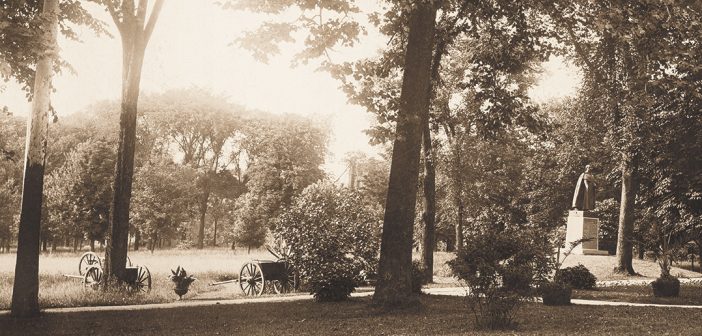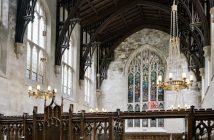Today, as we celebrate Fordham’s auspicious founding, we reflect on the story of an Irish immigrant who sought to elevate his people—and all immigrants—with the promise of higher education. Below is a 2016 homily delivered by Monsignor Thomas J. Shelley, Ph.D., GSAS ’66, professor emeritus of theology at Fordham.
Founding Father: Archbishop John Hughes
Lady Chapel, St. Patrick’s Cathedral, June 24, 2016
219 years ago today, on June 24, 1797, St. John’s Day, Fordham’s founding father, John Joseph Hughes, was born in the little village of Annalogan in County Tyrone, Ireland. “They told me when I was a boy,” he said, “that for the first five days I was on a social and civil equality with the most favored subject of the British Empire. These five days would be the interval between my birth and my baptism.” Once John Hughes was baptized a Catholic, however, like every Catholic in eighteenth-century Ireland, he immediately became a second-class citizen in the land of his birth.
John Hughes also preserved another vivid childhood memory. When his younger sister died, after the funeral Mass, the parish priest led the funeral procession to the local cemetery, which was the property of the Protestant Church of Ireland. Catholic priests were forbidden by law from entering these cemeteries. And so, outside the gate of the cemetery, the parish priest bent down, scooped up a clump of earth in his hands, blessed it, and handed it to Hughes’s father to sprinkle it over his daughter’s coffin as it was lowered into the grave. Childhood memories of this kind are not easily erased, and John Hughes never forgot this example of the prejudice suffered by Catholics in his native land.
John Hughes spent the first twenty years of his life in Ireland as the son of a poor Ulster farmer where he experienced not only prejudice but also the grinding poverty that prevented him from obtaining more than a rudimentary education. When he emigrated to America in 1817, he worked in the only occupations for which he was qualified, as a laborer in the construction trades and in quarries. When he applied for admission to a seminary to study for the priesthood, he had to spend his first year in remedial studies in order to qualify for the entrance requirements.
Exposure to prejudice and poverty was not limited to John Hughes. It was the common experience of Irish Catholics both in their homeland and in America. However, the difference was that America was the land of opportunity for immigrants, if they had the education to take advantage of these opportunities. This was one of the primary motives that led Bishop Hughes to establish St. John’s College at Fordham in 1841. He considered education the indispensable means for the members of his immigrant flock to break loose from the cycle of poverty that ensnared them and that prevented them from participating in what today we would call the American dream. John Hughes’s first biographer, John Hassard, a graduate of St. John’s College, Fordham, in 1855, and Hughes’s former secretary who knew him well, said, “The subject that of all others that [Hughes] had nearest his heart was education.”
A public official who saw what Hughes was doing and came to admire him greatly was William Seward, the politically astute governor of New York State. Later, as secretary of state during the Civil War, Seward became the indispensable man in Lincoln’s cabinet. Governor Seward told Hughes, “You have begun a great work in the elevation of the rejected immigrant, a work auspicious to the destiny of that class and still more beneficial to our common country.” Incidentally Hughes never made a distinction between Catholic and non-Catholic immigrants. He framed the issue this way, that foreign-born American citizens should enjoy the same legal rights as native-born American citizens.
Bishop Hughes became the effective leader of New York Catholics in June 1839. Only two months later he made his first major decision when he purchased 106 acres at Rose Hill for a college, which confirms the statement of John Hassard that “the subject of all others that [Hughes] had nearest his heart was education.” The price of the real estate was $30,000 ($29,750) and Hughes needed an additional $10,000 to renovate the two buildings on the property. “I had not, when I purchased the site of this new college, St. John’s, Fordham,” Bishop Hughes said, “so much as a penny wherewith to commence the payment for it.” He immediately launched a fund-raising campaign among New York’s impoverished Catholics. After nine months the campaign netted a paltry $10,000. Hughes then went to Europe on a ten-month begging trip, and generous Catholics in France and Austria contributed the money that he needed to start St. John’s College at Fordham.
John Hughes’s new college opened its doors 175 years ago today, on St. John’s Day, June 24, 1841, with a grand total of six students. The faculty was larger than the student body. For the next five years Hughes struggled to maintain his college as a diocesan institution with a faculty of New York diocesan priests, but it was a losing battle. There were four presidents in five years. One president became a cardinal, another became an archbishop, but neither of them was a professional educator.
Then there was a third diocesan priest as president, the ineffable and eminently forgettable Ambrose Manahan, a scatterbrain cleric whom Hughes dismissed for incompetence. When Hughes gave him his walking papers, he sent him this priceless letter, “I advise you to resign . . . in the almost extinguished hope that, on a new scene where your future character will be determined by your future conduct, you may disappoint the melancholy anticipations that the past is too well calculated to inspire.” Fordham’s founding father may not have had much formal education, but he certainly possessed the innate Irish gift of eloquence.
Fordham’s fourth and most capable diocesan president was a young cleric named Father John Harley, but he died at the age of twenty-nine, a not uncommon occurrence at that time because of the rigors of seminary education. Hughes had no one among his own diocesan clergy to replace Harley, and so in 1845 he turned to the Society of Jesus, an international order of scholars with a reputation as professional educators, to take charge of his fledgling college. The Jesuits in turn were happy to establish a foothold in the largest city in the United States.
Although St. John’s College remained a diocesan college for only five years, we rightly honor Archbishop John Hughes today as our founding father. It was he who purchased the property at Rose Hill, raised the funds to pay for it, recruited the original faculty and administration, obtained the state charter and left to the Jesuits a flourishing little college whose ownership they were happy to obtain. It was no mean accomplishment even for a man of the stature of John Joseph Hughes.
I do not think that the influence of John Hughes on Fordham University is limited to the past. In many respects he remains an inspiration for us today. For example, you are all familiar with the statue of Archbishop Hughes outside Cunniffe House on the Rose Hill campus. That statue was the gift of the alumni on the occasion of the fiftieth anniversary of St. John’s College, Fordham, in 1891. Many of the alumni would have known Hughes when they were students. Hughes had only been dead for 27 years.
The alumni wanted these words of John Hughes to be engraved on the pedestal of the statue: “I have always preached that every denomination, Jews, Christians, Catholics, Protestants—of every shade and sex—were all entitled to entire freedom of conscience, without let or hindrance from any sect or number of sects, no matter how small their number or how unpopular the doctrine that they profess.”
Unfortunately those words of John Hughes were not engraved on the pedestal of his statue perhaps, perhaps—and here I am only guessing—because the theologically conservative Jesuit Fathers at Fordham considered John Hughes’s words to be too bold and radical. They certainly would have set off alarm bells in the Vatican. However, in 1965, the Second Vatican Council effectively if posthumously endorsed those words of Archbishop Hughes in its Declaration on Religious Liberty and in Nostra Aetate, the council’s document on the relationship between the Catholic Church and the Jewish people. Isn’t it inspiring to know that, at least in this all-important area of freedom of conscience, our founding father anticipated the work of the Second Vatican Council by a whole century?
John Hughes was no Mother Theresa. He will never be canonized because, among his many other qualities, he was a tough and feisty street fighter who gave no quarter and asked no quarter in an often hostile environment. In 1844 a Nativist mob unleashed several days of rioting and violence on the Catholic community in Philadelphia. They then threatened to do the same thing in New York City. Bishop Hughes told the Nativist mayor of New York City, James Harper, that, if any harm came to his churches, he would turn the city into “a second Moscow,” a reference to the destruction of Moscow by the Russians in 1812 when Napoleon attacked the city.
That does not sound like Mother Theresa. To be honest, it is also far removed from the spirit of the Sermon on the Mount. But it worked and may be justified on the grounds that it preserved peace and law and order. The Nativist leaders backed down and disbanded their mob and spared New York City from the violence that only days earlier had engulfed the city of Philadelphia.
Many historians have criticized Archbishop Hughes for his bellicose style of leadership, but at least one distinguished historian of American Catholicism, Monsignor John Tracy Ellis, offered a more nuanced appraisal of John Hughes’s leadership. Ellis said that “there were times when [Hughes’s’] very aggressiveness was about the only approach that would serve the end that he was seeking, viz., justice for his people.” An integral element in his quest to obtain justice for his people and to give them economic and social equality in American society was to give them access to higher education. That is why he went to such great pains to establish the university whose 175th anniversary we celebrate today.
It is difficult to envision anyone else in the Catholic community in nineteenth-century New York City who could have accomplished what Archbishop John Hughes did for “the elevation of the rejected immigrant” (to quote again Governor William Seward). A key element in Archbishop Hughes’s plan to elevate the rejected immigrant was to give them the opportunity for a college education. We all owe him a great debt of gratitude for establishing St. John’s College at Rose Hill, the future Fordham University. It is a debt that we gladly acknowledge today and will continue to acknowledge and repeat in many different ways over the course of the next twelve months.
Thomas J. Shelley



